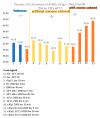Innovative High-Pressure Fabrication Processes for Porous Biomaterials-A Review
- PMID: 34821736
- PMCID: PMC8614988
- DOI: 10.3390/bioengineering8110170
Innovative High-Pressure Fabrication Processes for Porous Biomaterials-A Review
Abstract
Biomaterials and their clinical application have become well known in recent years and progress in their manufacturing processes are essential steps in their technological advancement. Great advances have been made in the field of biomaterials, including ceramics, glasses, polymers, composites, glass-ceramics and metal alloys. Dense and porous ceramics have been widely used for various biomedical applications. Current applications of bioceramics include bone grafts, spinal fusion, bone repairs, bone fillers, maxillofacial reconstruction, etc. One of the common impediments in the bioceramics and metallic porous implants for biomedical applications are their lack of mechanical strength. High-pressure processing can be a viable solution in obtaining porous biomaterials. Many properties such as mechanical properties, non-toxicity, surface modification, degradation rate, biocompatibility, corrosion rate and scaffold design are taken into consideration. The current review focuses on different manufacturing processes used for bioceramics, polymers and metals and their alloys in porous forms. Recent advances in the manufacturing technologies of porous ceramics by freeze isostatic pressure and hydrothermal processing are discussed in detail. Pressure as a parameter can be helpful in obtaining porous forms for biomaterials with increased mechanical strength.
Keywords: bioceramics; biodegradable polymers; freeze isostatic pressure; high pressure processing; metallic implants; porous biomaterials.
Conflict of interest statement
The authors declare no conflict of interest.
Figures









Similar articles
-
Biodegradable Materials and Metallic Implants-A Review.J Funct Biomater. 2017 Sep 26;8(4):44. doi: 10.3390/jfb8040044. J Funct Biomater. 2017. PMID: 28954399 Free PMC article. Review.
-
Fabrication, Properties and Applications of Dense Hydroxyapatite: A Review.J Funct Biomater. 2015 Dec 21;6(4):1099-140. doi: 10.3390/jfb6041099. J Funct Biomater. 2015. PMID: 26703750 Free PMC article. Review.
-
Current progress in inorganic artificial biomaterials.J Artif Organs. 2011 Sep;14(3):163-70. doi: 10.1007/s10047-011-0585-5. Epub 2011 Jul 7. J Artif Organs. 2011. PMID: 21748443 Review.
-
Fabrication Aspects of Porous Biomaterials in Orthopedic Applications: A Review.ACS Biomater Sci Eng. 2018 Jan 8;4(1):1-39. doi: 10.1021/acsbiomaterials.7b00615. Epub 2017 Dec 12. ACS Biomater Sci Eng. 2018. PMID: 33418675
-
Prospects and strategies for magnesium alloys as biodegradable implants from crystalline to bulk metallic glasses and composites-A review.Acta Biomater. 2020 Feb;103:1-23. doi: 10.1016/j.actbio.2019.12.023. Epub 2019 Dec 24. Acta Biomater. 2020. PMID: 31881312 Review.
Cited by
-
Effect of High-Pressure Treatments on the Properties of Food Packaging Materials with or without Antimicrobials.Polymers (Basel). 2022 Dec 17;14(24):5535. doi: 10.3390/polym14245535. Polymers (Basel). 2022. PMID: 36559902 Free PMC article.
-
Polymeric Scaffolds Used in Dental Pulp Regeneration by Tissue Engineering Approach.Polymers (Basel). 2023 Feb 21;15(5):1082. doi: 10.3390/polym15051082. Polymers (Basel). 2023. PMID: 36904323 Free PMC article. Review.
-
Three-Dimensional Plotted Calcium Phosphate Scaffolds for Bone Defect Augmentation-A New Method for Regeneration.J Pers Med. 2023 Mar 2;13(3):464. doi: 10.3390/jpm13030464. J Pers Med. 2023. PMID: 36983646 Free PMC article.
References
-
- Jodati H., Yılmaz B., Evis Z. A review of bioceramic porous scaffolds for hard tissue applications: Effects of structural features. Ceram. Int. 2020;46:15725–15739. doi: 10.1016/j.ceramint.2020.03.192. - DOI
-
- Baino F., Ferraris M. Learning from Nature: Using bioinspired approaches and natural materials to make porous bioceramics. Int. J. Appl. Ceram. Technol. 2017;14:507–520. doi: 10.1111/ijac.12677. - DOI
-
- Baino F., Fiume E., Barberi J., Kargozar S., Marchi J., Massera J., Verné E. Processing methods for making porous bioactive glass-based scaffolds—A state-of-the-art review. Int. J. Appl. Ceram. Technol. 2019;16:1762–1796. doi: 10.1111/ijac.13195. - DOI
-
- Hedayat N., Du Y., Ilkhani H. Review on fabrication techniques for porous electrodes of solid oxide fuel cells by sacrificial template methods. Renew. Sustain. Energy Rev. 2017;77:1221–1239. doi: 10.1016/j.rser.2017.03.095. - DOI
Publication types
LinkOut - more resources
Full Text Sources

